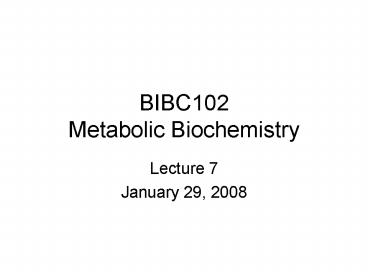BIBC102 Metabolic Biochemistry PowerPoint PPT Presentation
1 / 45
Title: BIBC102 Metabolic Biochemistry
1
BIBC102Metabolic Biochemistry
- Lecture 7
- January 29, 2008
2
OH
Figure 15-3
3
Can reduce Cu2
Oxidized sugar
Cannot reduce Cu2
Figure 7-10
Note this shows the ß, not a configuration
4
Figure 7-15b
5
3 enzymes of glycogen breakdown(Glycogenolysis)
- glycogen phosphorylase
- glycogen debranching enzyme
- phosphoglucomutase
6
Pyridoxal phosphate cofactor
Figure 15-3
7
Pyridoxal phosphate cofactor
1
2
3
4
1
2
3
4
Figure 15-4
8
3 enzymes of glycogen breakdown(Glycogenolysis)
- glycogen phosphorylase
- glycogen debranching enzyme oligo (a1?6) to
(a1?4) glucantransferase - phosphoglucomutase
9
1
2
3
4
1
2
3
4
1
1
2
3
4
2
3
4
Figure 15-4
10
Hydrolysis, NOT Phosphorolysis
Figure 15-4
11
LNC 15.13
12
3 enzymes of glycogen breakdown(Glycogenolysis)
- glycogen phosphorylase
- glycogen debranching enzyme
- Phosphoglucomutase
- Glu-1-P ? Glu-6-P
13
Glu-1P ? Glu-6P phosphoglucomutase
Figure 15-5
14
GLYCOGEN METABOLISM
GLYCOGEN SYNTHESIS
LNC Chapter 15 (Section 1)
15
Activation of Glucose Formation of a
Sugar-Nucleotide
16
UDP glucose is the activated precursor
p. 565
17
Glu ATP ? Glu-6-P ADP
- Enzymes
- hexokinase I and
- hexokinase II in muscle,
- hexokinase IV (glucokinase) in liver
18
Glu-6-P ? Glu-1-P
- Phosphoglucomutase
19
Glu-1-P UTP ? UDP-Glu PPi
Glu-1-P
UTP
PPi
UDP-Glu
Figure 15-7
20
- Distinction between
- Chain Initiation
- Chain Elongation
- Branching
21
Start with glycogenin, a primer and
enzyme. Muscle form and Liver form
(glycogenin-2)
Figure 15-10
UDP-glucose
22
Figure 15-11a
23
LNC (3rd ed) 20-14 (not found in 4th edition)
24
(Glu)n UDP-Glu ? (Glu)n1) UDP
Figure 15-8
25
Figure 15-9
26
each glycogen molecule has many non-reducing ends
Figure 15-11b
27
Glycogen Storage Diseases of Humans
28
(No Transcript)
29
GLYCOGEN UDP-Glu
Glu-1P Glu-6P Fru-6P Fru-1,6 bis
P DHAP GAP
synthase
phosphorylase
Fructose-1,6-bis phosphatase
Phosphofructokinase (PFK-1)
30
GLYCOGEN UDP-Glu
Glu-1P Glu-6P Fru-6P Fru-1,6 bis
P DHAP GAP
phosphorylase
synthase
Fructose-1,6-bis phosphatase
Phosphofructokinase (PFK-1)
31
(Glu)n Pi ? (Glu)n-1 Glu 1-P
Glu (Glu)n ? (Glu) n1
Glu ATP ? ADP Glu
6-P Glu 1-P UTP ? UDP-Glu UMP
2Pi
32
PROTEIN PHOSPHORYLATIONA MECHANISM TO CONTROL
ACTIVITY
Fig 15-14
33
Covalent modifications
least active
Ligand-induced conformational changes
most active
34
b
a
Fig 15-24
35
aT
aR
bT,R
GLUCOSE IS A LIGAND ACTING AS A NEGATIVE MODULATOR
Fig 15-26
36
A SIGNAL TRANSDUCTION PATHWAY
37
cAMP is a second messenger in cells
adenyl cyclase
ATP
cAMP
phosphodiesterase
ADP
AMP
38
cAMP-dependent Protein Kinase
LNC 12-15
39
cGMP is another second messenger in cells
guanyl cyclase
GTP
cGMP
phosphodiesterase
GMP
40
(No Transcript)
41
liver
muscle
Fig 15-25
42
GLYCOGEN UDP-Glu
Glu-1P Glu-6P Fru-6P Fru-1,6 bis
P DHAP GAP
synthase
phosphorylase
Fructose-1,6-bis phosphatase
Phosphofructokinase (PFK-1)
43
Insulin keeps GSK3 inactive
Priming by casein kinase II
PROTEIN PHOSPHATASE
Fig 15-27
44
Fig 15-29
45
End of Lecture 7
- Janauary 29, 2008

